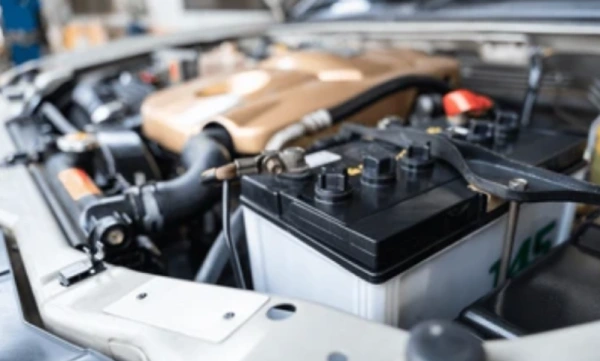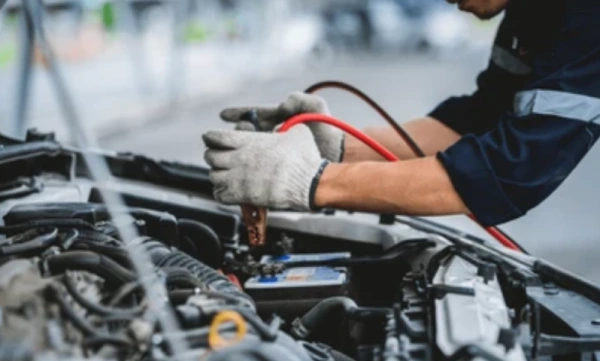
- Part 1. What is a Car Battery?
- Part 2. Why is a Battery Used in a Car?
- Part 3. Composition of Car Battery Cell
- Part 4. How Does a Car Battery Work?
- Part 5. How Car Batteries Produce Electricity
- Part 6. How Long Do Car Batteries Last
- Part 7. What Factors Affect the Lifespan of the Batteries
- Part 8. Types of Battery with Average Lifespan
- Part 9. Conclusion
In 1859, French physicist Gaston Planté invented lead-acid batteries. It’s been 150 years since car batteries are powering modern vehicles. If we talk about the present time, these batteries are used to power the car radio, starter motor, and everything in between. If we discuss car efficiency and neglect batteries, it would be an unfair deal. Without it, your car would be a non-moveable hunk of metal. So, the question arises: how does a car battery work? And what makes it more efficient to work last?
So, in this article, we will deal with how car batteries work. We will deal with their composition, components, working, and applications. Moreover, we will learn about their limitations here as well. We will help you understand the different types of car batteries available on the market and what battery suits you better.
Part 1. What is a Car Battery?

A lead-acid battery is commonly known as a car battery. It is mainly composed of lead plates. These plates are submerged in acid. Then, this whole setup allows the creation of a chemical reaction. During this reaction, the battery stores chemical energy and releases electrical energy to give us voltage and current.
On the other hand, the batteries are rechargeable. When we expose it to electricity, it stores the electrical energy, converts it into chemical energy, and recharges the battery.
Hence, car batteries play an essential role in our cars. It provides the necessary electrical energy to start the car engine. Thus, car batteries have a fundamental role in the functionality of our automobiles. They are indispensable, so if you are a car owner, learning how a car battery works is essential.
Part 2. Why is a Battery Used in a Car?
A car battery provides power to the vehicle. It works like a surge protector. Moreover, it is used to power up short-term use. So, let’s discuss some functions of car batteries.
- Starting the engine: The most crucial function of car batteries is they give initial power to crank the engine. This power begins the combustion process and starts the car.
- Power up electrical systems: As we know, sometimes the car engine is off, but you still need to turn on your car’s ACs, wipers, or other functions. In this case, the car battery gives power to these electrical things. These include light, radio, stereo, GPS, air conditioner, heater, and windows.
- Stabilizes the electrical supply: The car battery stabilizes the voltage in the electrical system. Moreover, it supplies power to different components of the vehicle.
- Backup power: If your alternator fails or the engine stops working, the car battery is a blessing in disguise. It works as a power backup and temporarily operates the car.
- Electronic systems: Now, advanced vehicles offer a variety of electronic systems. These systems may include fuel injection, safety systems, and engine management. These all rely on the stable power supply of car batteries.
Part 3. Composition of Car Battery Cell
We generally refer to lead-acid batteries as car batteries. They consist of various components. These components work collectively and give electrical energy to your vehicle. So, here we will discuss the composition of car battery cells.
- Lead Plates: These plates are present inside the battery. They are made up of lead-antimony alloy and submerged in an acidic solution, i.e., Sulfuric acid (H2SO4). This whole solution helps in chemical reactions and results in the release of electrical energy.
- Electrolyte: The electrolyte solution, composed of sulfuric acid and water, facilitates the flow of ions between the lead plates during the electrochemical reactions. It plays a crucial role in generating electrical energy.
- Separators: These are porous insulating materials. They are placed between lead plates, which helps prevent direct contact with each other. Moreover, they allow the electrolyte to flow freely and avoid short circuits.
- Casing: It’s the outer body of the battery. It is usually made up of polypropylene. It provides resistance to corrosion from the acidic electrolytic solution. Moreover, it maintains electrolytes inside it and manages the structural integrity of the battery.
- Terminals: The battery has two terminals; one is positive, and the other is negative. These terminals connect the battery to the car’s electrical system.
Part 4. How Does a Car Battery Work?

Have you ever thought of how your car’s battery makes everything work? It gives power to several components. So, it’s more than just a simple box. It has a proper composition and mechanism associated with it. So, let’s discuss in detail how a car battery works.
1. Energy Conversion and Chemical Reactions Inside Battery Cell
The car battery undergoes chemical reactions. These reactions result in the discharging and charging of the battery. So, it is essential to know how these reactions take place. So, to keep a long story short, when the lead plates interact with an electrolytic solution, i.e., Sulphuric acid, the battery undergoes these reactions. So, let’s understand these reactions and the proper working of the parts.
2. How Does the Car Battery Discharge
The negative lead plates and Sulphuric acid electrolytes go through chemical reactions. It is the point when the car battery discharges. Here, the lead plates are negatively charged and act as anodes. They react with sulfate ions (SO4^2-), which are present in electrolytes. As a result, they release electrons. So, here is a general chemical reaction that occurs at the anode.
Pb + SO4^2- → PbSO4 + 2e^-
On the other hand, the positive lead plate acts as a cathode. So, lead dioxide (PbO2) reacts with sulfate ions and water. As a result, they form lead sulfate and release electrons. Then, these electrons flow in the circuit and generate an electric current. These currents power the car’s electrical systems. So, the chemical reaction that occurs at this plate can be given as,
PbO2 + SO4^2- + 4H^+ + 2e^- → PbSO4 + 2H2O
3. How Does the Car Battery Charge?
The charging process is the opposite of discharging. The reverse chemical reactions occur during this process. So, when we apply the electrical current externally, the negative lead plate also works as an anode, converting the lead sulfate into lead and sulfate ions. At the same time, the electron that is released during discharging is again pushed back to the plate. So, here is a chemical equation.
PbSO4 + 2e^- → Pb + SO4^2-
Furthermore, the positive plate (cathode) converts the lead sulfate into lead oxide and water. It also absorbs the electrons into the plate again. So, its chemical reaction is,
PbSO4 + 2H2O → PbO2 + SO4^2- + 4H^+ + 2e^-
So, this process is effective for restoring the chemical composition of lead plates. Moreover, it allows the battery to store the electrical energy for later use.
Part 5. How Car Batteries Produce Electricity
A car battery undergoes an electrochemical process. That process results in electrical energy. The battery is composed of lead dioxide and lead plates. These plates are submerged in the electrolyte. These plates act as anode (-ve charge) and cathode (+ve charge)
When the chemical reactions take place at the terminals of the car battery, they release electrons. Then, this flow of electrons produces electricity. This electrical energy serves as a power source for several components of vehicles, such as starter motors, lights, and radios.
Part 6. How Long Do Car Batteries Last
We cannot directly estimate the lifespan of the battery. Several factors can increase or decrease life. These factors include usage frequency, weather conditions, maintenance, and quality. If we talk about average lifespan, a car battery lasts for 3- to 5 years. However, a few batteries can go long if you properly care about and maintain them.
Part 7. What Factors Affect the Lifespan of the Batteries
So, here are some factors that affect battery life. They will help us understand how a car battery works.
- Climate: Both hot and cold temperatures significantly impact battery life. In hot conditions, the chances of fluid evaporation are high. So they can lead to internal corrosion. On the other hand, the cold weather reduces the battery’s ability to store charge.
- Driving Habits: If you drive for short trips and frequently repeat the stop-and-go cycle, your battery can drain fast. Especially in highway driving, when the battery drains fast, the alternator may only charge forickly.
- Car Electrical Load: Modern cars now come with various electrical systems. These features can add additional strain on the battery and reduce its lifespan.
- Appropriate Maintenance: The Car battery requires proper maintenance after some time. This maintenance may include clean terminals and tight electrolyte levels. If they are well-maintained, they can extend the life of a car battery.
- Battery Quality: If your battery is of bad quality, it will drain rapidly. However, if you have a higher-quality battery, it will have a longer lifespan.
Part 8. Types of Battery with Average Lifespan
Here is a detailed table of different types of car batteries available in the market. So, you can learn which car batteries last longer and what factors reduce their lives. Moreover, how can you maintain your batteries?
The lifespan of different car batteries
| Battery Type | Lifespan (Average) | Factors Affecting Lifespan | Maintenance Tips |
|---|---|---|---|
| Lead-Acid | 3-5 years | Usage patterns, temperature extremes | Regularly check electrolyte levels, and keep terminals clean |
| Absorbent Glass Mat (AGM) | 4-7 years | Temperature fluctuations, deep discharge cycles | Ensure proper charging, avoid overcharging, and maintain proper ventilation |
| Gel Cell | 4-6 years | Quality of materials, maintenance routines | Secure terminals tightly, avoid overcharging and follow the manufacturer’s guidelines |
| Lithium-Ion | 5-10 years | Proper charging, depth of discharge | Avoid deep discharges, use compatible charging systems |
| Enhanced Flooded Battery (EFB) | 3-5 years | Usage patterns, temperature fluctuations | Regularly check electrolyte levels, and perform equalization charges if necessary |
Part 9. Conclusion
So, how does a car battery work? Batteries play a significant role in cars. They undergo chemical reactions and convert the chemical energy into electrical energy. Moreover, the car batteries are rechargeable. They have different lifespans, which depend on various factors and conditions. Thus, they even provide temporary power to the engine if your alternator does not work. So, they are a vital component of any modern vehicle.
Related Tags:
More Articles
Overview of Deep Cycle Lithium Battery
In this article, we explore the life, voltage, capacity, and charging considerations of deep cycle lithium batteries.
How Long do Lithium Batteries Last?
How long do lithium batteries last? we will explore the factors that influence the lifespan of lithium batteries and provide insights into their longevity.
How to Choose the Best LiFePO4 Battery?
Choose LiFePO4 batteries for superior performance, safety, and versatility in EVs, UPS, and backup power. This guide helps you make informed decisions.
Get 12v Lithium Car Battery As a Power Source for the Ride
Make the right choice for your vehicle's battery needs by installing a 12 volt lithium car battery. You will enjoy maintenance-free longevity with this change.



